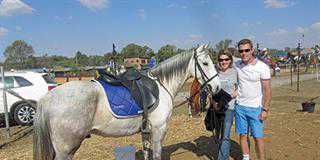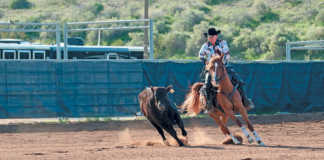Very few riders are confident with jumping. This is strange because horses have a very natural ability to jump. Their psychology programmes our horses to pick up on our confidence. Most riders are nervous at the thought of jumping. Ask any rider if they can jump and the answer will almost always be no; but this isn’t always true. Most riders don’t want to jump over BIG fences. It’s easy to make a jump over a pole that’s raised only a few centimetres off the ground, but higher than that is a different story!
Some riders won’t even contemplate jumping, and this is also fine! The first rule of confidence is realising that you have a choice. You aren’t compelled to do something that you don’t feel happy about. Ask those that don’t jump if they would like to jump – 90% say they would if they had the nerve. Luckily, there are many ways to overcome your fear of jumping.
Conquer your fear
Jumping is a mini adrenaline rush. Most riders approach jumping as a big event instead of an everyday part of riding. They get so worked up about jumping that logic flies out of the window. If you think about something in a fearful or negative way, your brain will begin to believe in that fear and negativity. The more you think in this way, the stronger the fear becomes.
This is because your fear gets hard wired into the amygdala – the area of the brain that handles survival instinct and our emotions. The logical part of our brain – the cortex – has fewer neurological connections running to the amygdala than vice versa. This means logic often can’t override emotions. The answer to overcoming fear is to “rewire” your brain.
Visualisation (picturing yourself doing the perfect jump) can be used to reach the outcome that you want. Another simple way to overcome fear is to set up a course of really high jumps, ride around them without attempting to jump them at first, then raise them a little more, and keep riding around the jumps. Finally put the jumps down one hole at a time until you are comfortable enough to jump.
This tactic really works, if you’d like to try it you should find a trainer you can trust, one who will move at your pace. Then try to practice on a horse that is well schooled, one that wants to jump. Often, if a horse refuses to jump, it is because you have stopped as you rode into the fence, especially if you were expecting trouble. Recreate all the odd fences at home so that at a show everything looks normal to your horse. This way you will not spot “the one he’ll stop at.”
Always use the same sort of routine. First a warm up, then trotting poles before moveing onto something more demanding. Don’t leave the arena 1til you’re ready to handle more than you were when you arrived. If you practise on your own, only make the jumps you feel comfortable with making.
Remember, the more you practise, the more your brain will trust the process. Very often I find that if someone does in-hand jumping with their horse they find peace, because they can visualise what their horse looks like when jumping. I find it easier to relax when I can see how my horse reacts when he jumps on the end of a lunge line. And I find my horse and I bond during this exercise.
Contact Kim Dyson on 082 888 6511.













